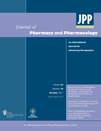Myrtenal inhibits acetylcholinesterase, a known Alzheimer target
Corresponding Author
Dorothea Kaufmann
Institute of Pharmacy and Molecular Biotechnology, Department of Biology, Ruprecht-Karls-University Heidelberg, Heidelberg, Germany
Dorothea Kaufmann, Institute of Pharmacy and Molecular Biotechnology, Department of Biology, Ruprecht-Karls-University Heidelberg, Im Neuenheimer Feld 364, 69120 Heidelberg, Germany. E-mail: [email protected]Search for more papers by this authorAnudeep Kaur Dogra
Centre for Pharmacognosy and Phytotherapy, The School of Pharmacy, University of London, London, UK
Search for more papers by this authorMichael Wink
Institute of Pharmacy and Molecular Biotechnology, Department of Biology, Ruprecht-Karls-University Heidelberg, Heidelberg, Germany
Search for more papers by this authorCorresponding Author
Dorothea Kaufmann
Institute of Pharmacy and Molecular Biotechnology, Department of Biology, Ruprecht-Karls-University Heidelberg, Heidelberg, Germany
Dorothea Kaufmann, Institute of Pharmacy and Molecular Biotechnology, Department of Biology, Ruprecht-Karls-University Heidelberg, Im Neuenheimer Feld 364, 69120 Heidelberg, Germany. E-mail: [email protected]Search for more papers by this authorAnudeep Kaur Dogra
Centre for Pharmacognosy and Phytotherapy, The School of Pharmacy, University of London, London, UK
Search for more papers by this authorMichael Wink
Institute of Pharmacy and Molecular Biotechnology, Department of Biology, Ruprecht-Karls-University Heidelberg, Heidelberg, Germany
Search for more papers by this authorAbstract
Objectives Inhibition of acetylcholinesterase (AChE) is a common treatment for early stages of the most general form of dementia, Alzheimer's disease. In this study selected components of essential oils, which carry a variety of important functional groups, were tested for their in-vitro anti-acetylcholinesterase activity.
Methods In-vitro anti-acetylcholinesterase activity was measured by an adapted version of Ellman's colorimetric assay.
Key findings 1,8-cineole, carvacrol, myrtenal and verbenone apparently inhibited AChE; the highest inhibitory activity was observed for myrtenal (IC50 = 0.17 mm). This is the first study showing the AChE inhibitory activity of myrtenal.
Conclusions Our investigations provided evidence for the efficacy of monoterpenes as inhibitors of AChE.
References
- 1 Czech C et al. Presenilins and Alzheimer's disease: biological functions and pathogenic mechanisms. Prog Neurobiol 2000; 60: 363–384.
- 2 Cummings JL. Cognitive and behavioral heterogeneity in Alzheimer's disease: seeking the neurobiological basis. Neurobiol Aging 2000; 21: 845–861.
- 3 Alzheimer's Association. 2010 Alzheimer's Disease Facts and Figures. 2011.
- 4 Brookmeyer R et al. Forecasting the global burden of Alzheimer's disease. Alzheimers Dement 2007; 3: 186–191.
- 5 Bartus RT et al. The cholinergic hypothesis of geriatric memory dysfunction. Science 1982; 217: 408–414.
- 6 Courtney C et al. Long-term donepezil treatment in 565 patients with Alzheimer's disease (Ad 2000): randomised double-blind trial. Lancet 2004; 363: 2105–2115.
- 7 Munoz-Torrero D. Acetylcholinesterase inhibitors as disease-modifying therapies for Alzheimer's disease. Curr Med Chem 2008; 15: 2433–2455.
- 8 Sabbagh MN et al. Do cholinergic therapies have disease-modifying effects in Alzheimer's disease? Alzheimers Dement 2006; 2: 118–125.
- 9 Oh MH et al. Screening of Korean herbal medicines used to improve cognitive function for anti-cholinesterase activity. Phytomedicine 2004; 11: 544–548.
- 10 Hostettmann K et al. Natural product inhibitors of acetylcholinesterase. Curr Org Chem 2006; 10: 825–847.
- 11 Perry NS et al. Salvia for dementia therapy: review of pharmacological activity and pilot tolerability clinical trial. Pharmacol Biochem Behav 2003; 75: 651–659.
- 12 Miyazawa M, Yamafuji C. Inhibition of acetylcholinesterase activity by bicyclic monoterpenoids. J Agric Food Chem 2005; 53: 1765–1768.
- 13 Ateeque A, Misra LN. Terpenoids from Artemisia annua and constituents of its essential oil. Phytochemistry 1994; 37: 183–186.
- 14 Kameoka H, Nakai K. Components of essential oil from the root of Glycyrrhiza glabra. Nippon Nogei Kagaku Kaishi 1987; 61: 1119–1121.
- 15 Ellman GL et al. A new and rapid colorimetric determination of acetylcholinesterase activity. Biochem Pharmacol 1961; 7: 88–95.
- 16 Wink M. Evolutionary advantage and molecular modes of action of multi-component mixtures used in phytomedicine. Curr Drug Metab 2008; 9: 996–1009.
- 17 Inamori Y et al. Cytotoxic effect of hinokitiol and tropolone on the growth of mammalian cells and on blastogenesis of mouse splenic T cells. Biol Pharm Bull 1993; 16: 521–523.
- 18 Nishino H et al. Cancer chemoprevention by phytochemicals and their related compounds. Asian Pac J Cancer Prev 2000; 1: 49–55.
- 19 Dorman HJ, Deans SG. Antimicrobial agents from plants: antibacterial activity of plant volatile oils. J Appl Microbiol 2000; 88: 308–316.
- 20 Astani A et al. Comparative study on the antiviral activity of selected monoterpenes derived from essential oils. Phytother Res 2010; 24: 673–679.
- 21 Santos FA, Rao VS. Antiinflammatory and antinociceptive effects of 1,8-cineole a terpenoid oxide present in many plant essential oils. Phytother Res 2000; 14: 240–244.
- 22 do Vale TG et al. Central effects of citral, myrcene and limonene, constituents of essential oil chemotypes from Lippia alba (Mill.) n.e. Brown. Phytomedicine 2002; 9: 709–714.
- 23 Hosseinzadeh H, Sadeghnia HR. Safranal, a constituent of Crocus sativus (saffron), attenuated cerebral ischemia induced oxidative damage in rat hippocampus. J Pharm Pharm Sci 2005; 8: 394–399.
- 24 Main AR, Hastings FL. Carbamylation and binding constants for the inhibition of acetylcholinesterase by physostigmine (eserine). Science 1966; 154: 400–402.
- 25 Orhan I et al. Activity of essential oils and individual components against acetyl- and butyrylcholinesterase. Z Naturforsch C 2008; 63: 547–553.
- 26 Jukic M et al. In vitro acetylcholinesterase inhibitory properties of thymol, carvacrol and their derivatives thymoquinone and thymohydroquinone. Phytother Res 2007; 21: 259–261.
- 27 Mukherjee PK et al. Acetylcholinesterase inhibitors from plants. Phytomedicine 2007; 14: 289–300.
- 28 Adams M et al. Plants traditionally used in age related brain disorders – a survey of ethnobotanical literature. J Ethnopharmacol 2007; 113: 363–381.
- 29 Chemcas. http://www.chemcas.org., accessed February 22nd, 2011.




